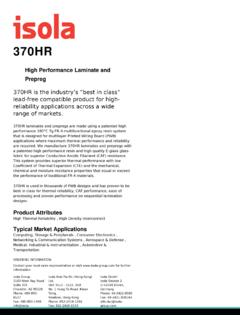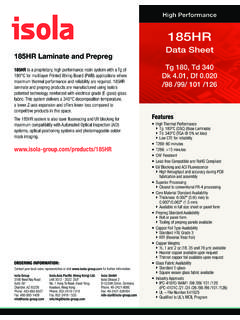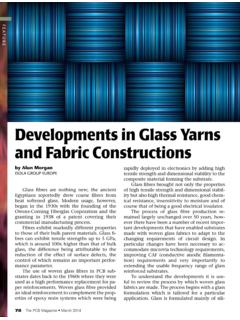Transcription of PCB Material Selection for High-speed Digital Designs
1 PCB Material Selection for High-speed Digital Designs Add a subtitle Outline Printed Circuit Boards (PCBs) for High-speed Digital (HSD) applications PCB factors that limit High-speed Digital performance PCB Material Selection process and Isola product solutions Summary What is High-speed Digital ? Digital signaling requiring use of high frequency design to preserve signal integrity Traces electrically behave as transmission lines Crosstalk, attenuation, impedance mismatch are important Common rule of thumb for threshold associated with trace electrical length td > tr/4 td = line delay=delay/unit length*line length tr = 20% - 80% signal rise time High-speed Digital Definitions In the 1990s Digital signaling in electronics in 100 Mhz range was high speed Chips and computer performance have increased dramatically driving data rates to the Gbps range Today.
2 Data rates frequently exceed 10 Gbps and 25 Gbps signaling will be used to meet new demands HSD Applications Products utilizing high -performance PCBs include: Servers Routers Storage Area Networks Power Amplifiers Transceiver Modules high speed Data Channels (PCIe4 for example) Greatest demands on PCBs are those with highest data rates & longest channel lengths Ever Increasing Need for speed Rapid growth of server, network & internet traffic drives need for higher data rates Key contributors of data demand include: Internet Consumer Applications Cloud Computing and Storage Virtual Servers Advances in Scientific and Financial Computing Hardware Response to Demand Availability of 100G servers Migration to 100G Gen 2 using 4x25 Gbps channels IEEE-standard expected to be finalized mid-2014 defining 4-lane PHY for operation over PCB backplane Juniper T1600, Brocade MLX, Cisco CRS-3 RF/Microwave vs HSD PCBs RF/microwave PCBs traditionally have only a few layers.
3 In some cases just one or two PCBs for HSD applications often have 20 or more layers with hundreds of traces Materials suitable for RF/microwave may not be suitable for HSD due to processing considerations necessary for 20+ layer products RF/Microwave and HSD Similarities For RF/microwave PCBs sinusoidal signals travel through PCB Material and experience loss and distortion due to Dk & Df, skin effects For HSD PCBs trapezoidal-shaped Digital waveforms travel through Material experience attenuation, pulse broadening, timing errors Frequency of concern for Material properties can be the same in both cases 20% 80% Differential Signaling and HSD PCBs Differential signaling uses a differential pair of transmission lines The transmission lines have equal and opposite polarity signals traveling on them and are tightly timed to one-another Differential signaling has several advantages Insensitive to ground connection quality between two ends of signal path Data link maintains functionality with substantial attenuation in the channel Supports very high data rates versus single-ended signal paths Serial Differential Signaling is the Signaling Protocol for Modern HSD Designs PCB Factors that limit
4 HSD Performance PCB Laminate Material Considerations PCB laminates considered here consist of one or more plies of resin-impregnated glass cloth sandwiched between two copper foils The High-speed Digital performance of the laminate & resulting PCB depends on the quality of The resin The copper foil The weave of the glass PCB Dielectric Constant As a fiber/resin composite , PCB materials are inhomogeneous anisotropic dielectrics propagation speed within Material can vary depending on location of traces Trace over fiber bundle (1) and trace over resin-rich area (2) see different effective dielectric constants Differing propagation speeds creates timing skew & potential signaling errors resin < fiber (1) (2) PCB Material Dielectric Loss Dielectric materials have polarized molecules that move when subjected to the electric field of a Digital signal This motion produces heat loss Loss results in signal attenuation that increases in direct proportion to signal frequency E PCB Material Conduction Loss The copper contributes to overall loss through the metal s resistive losses At high signal frequencies, the current in PCB copper is concentrated within a small depth near its surface (skin effect)
5 Reduction in effective cross-sectional area increases the effective resistance Conductors on PCBs do not have perfectly smooth surfaces Rough copper improves peel strength of laminate Maximum peak-peak tooth size varies ~ 2-10 microns Surface roughness increases bulk copper resistance 10-50% Electrical impact of conductor roughness increases with increasing data rates Conductor Surface Roughness Trace Plane Conductor Surface Roughness Resist side Bonding side Signal Path The current is able to tunnel below the surface profile and through the bulk of the conductor The current is forced to follow every peak and trough of the surface profile increasing path length and resistance Standard foil ~10 m Copper Foil Definitions DSTF (Drum Side Treated Foil): Adhesion treatment is applied to shiny/drum side RTF (Reverse Treated Foil): Same as DSTF LP: Low Profile Foil with Tooth Microns VLP: Very Low Profile Foil with Tooth < 5 Microns e-VLP/H -VLP: Very Low Profile Foils STD HTE (Standard Shiny Copper): Adhesion treatment is applied to matte side RTF: Rq= um, RF= VLP.
6 Rq= um, RF= Surface Spikes Cause Increase in Capacitance Multiple spikes are about 10 um from top to bottom Electric field is singular on the spikes (similar to strip edges) Consistent for 2 line types About 5% increase for MSL with one RTF surface >10% increase for strip line with two RTF surfaces Consistent increase in group delay and decrease in characteristic impedance over very wide frequency band RTF foil The effect was first noticed in Deutsch, A. Huber, Kopcsay, B. J. Rubin, R. Hemedinger, D. Carey, W. Becker, T Winkel, B. Chamberlin, Accuracy of Dielectric Constant Measurement Using the Full-Sheet-Resonance Technique IPC-T650 p. 311-314, ., IEEE Symposium on Electrical Performance of Electronic Packaging, 2002 Adhesion Promoter Effects RTF Foil + Adhesion Promoter RTF Foil Shiny Foil Shiny Foil + Adhesion Promoter Courtesy of Viasystems x1 x2 x1 x2 Pitch (x3) y1 y2 y1 y2 Pitch (y3) x2 Pitch (x3) y2 Pitch (y3) Glass / Measurrments in mlsGlass Fabric Definitions Dimensions Fiber Weave Effect PCBs materials are inhomogeneous dielectrics laminates Inhomogeneous properties of PCB laminates lead to Fiber Weave Effects 106 1080 1067 2116 1086 Test board to Measure Fiber Weave Effects 8 layer stack-up with 2 microstrip layers (top and bottom) and 2 strip-line layers (L3, and L6) Microstrip Top.
7 RTF copper foil, 1080 prepreg, no solder mask Strip L3: RTF copper foil, laminate 1080 core and prepreg Strip L6: VLP copper foil, laminate 2116 core and prepreg Microstrip Bottom: VLP copper foil, laminate 2116 prepreg Test structures: 4-inch and 8-inch line segment with transitions to probe pads Two Main Fiber Weave Effects due to location of trace with respect to fiber weave bundles due to periodic loading of trace by fiber weave bundles resonance high Er; Low Zo Low Er; high Zo Ф Analytical Formulation of FWE Arbitrary Angle: Ф = 0 > 45 Challenge is to find/define the spatial period Separate the Weft and Warp loading Warp loading is in pitch scale high frequencies neglected Weft loading occurs in a larger scale lower frequencies key role Weft spatial period is obtained from trigonometric expressions: [] + =1)tan(122pitchperiodweft[] + =1)tan(1222pitchcfeffres Fiber Weave Effect: Angle (1080) Insertion and Return Loss, 4-inch traces Excellent agreement with analytical equation Strength of resonance increases with angle Insertion Loss Return Loss Angle [Deg] Equation 2 (GHz) Measured (GHz) 7 10 15 Fiber Weave Effect.
8 Angle (1080) Insertion and Return Loss, 8-inch traces Excellent agreement with analytical equation Resonances spread over frequency due to fiber weave imperfections Insertion Loss Return Loss 8in 4in Fiber Weave Effect: Angle (2116) Insertion and Return Loss, 4- and 8-inch traces No resonances were detected from measurement This is due to the denser and more homogeneous Material Insertion Loss Return Loss (8-in) Ways to Mitigate Fiber Weave Effects Use more uniform glass such as 2116 or 3113 shown These styles have more uniform distributions of glass across the entire surface greatly reducing impedance variations Use as wide a trace as practical for layout Route traces at an angle with respect to fiber warp/fill Use zig-zag routing Select materials having resin and fiber dielectric constants as close as possible to one another 3113 1080 PCB Material Selection Process and Isola Product Solutions PCB Material Selection Selecting the Right Material Laminate Material Selection can not be condensed into a single page chart for easy Selection high performance laminate Material suppliers have a much
9 Better understanding of Material performance Cost-to-performance evaluations must still be done by the system design team to ensure the lowest cost Material that will do the job is selected Key Laminate Performance Indicators Dielectric Constant (Dk) Matching Material performance numbers is important. A small difference in this value between materials can impact impedance, line widths, and thus losses significant Consider construction options that allow you to find a drop in and match impedance Dissipation Factor (Df) Values vary dramatically by resin content, resin type, frequency, and test method It is important to thoroughly understand the methods used to derive the numbers Compare Df to Df at equal test conditions and resin contents when looking at a suppliers data sheets Copper Type Low profile copper provides better results than standard profile copper RTF or DSTF type foils offer significant improvements in loss characteristics.
10 VLP foils are being used as well for better impedance FR408HR Dk vs Resin % ContentDkDkSummary Printed Circuit Boards (PCBs) for High-speed Digital (HSD) applications PCB factors that limit High-speed Digital performance PCB Material Selection process and Isola product solutions








